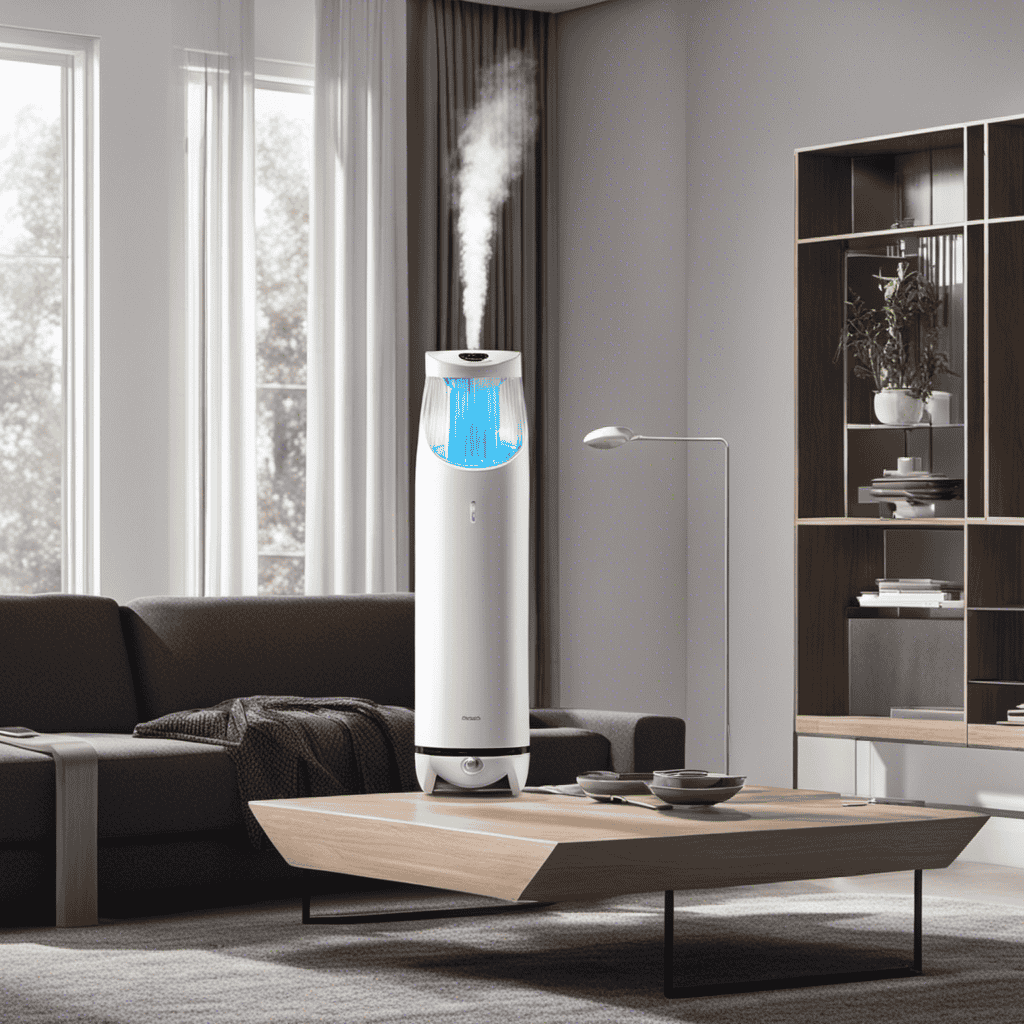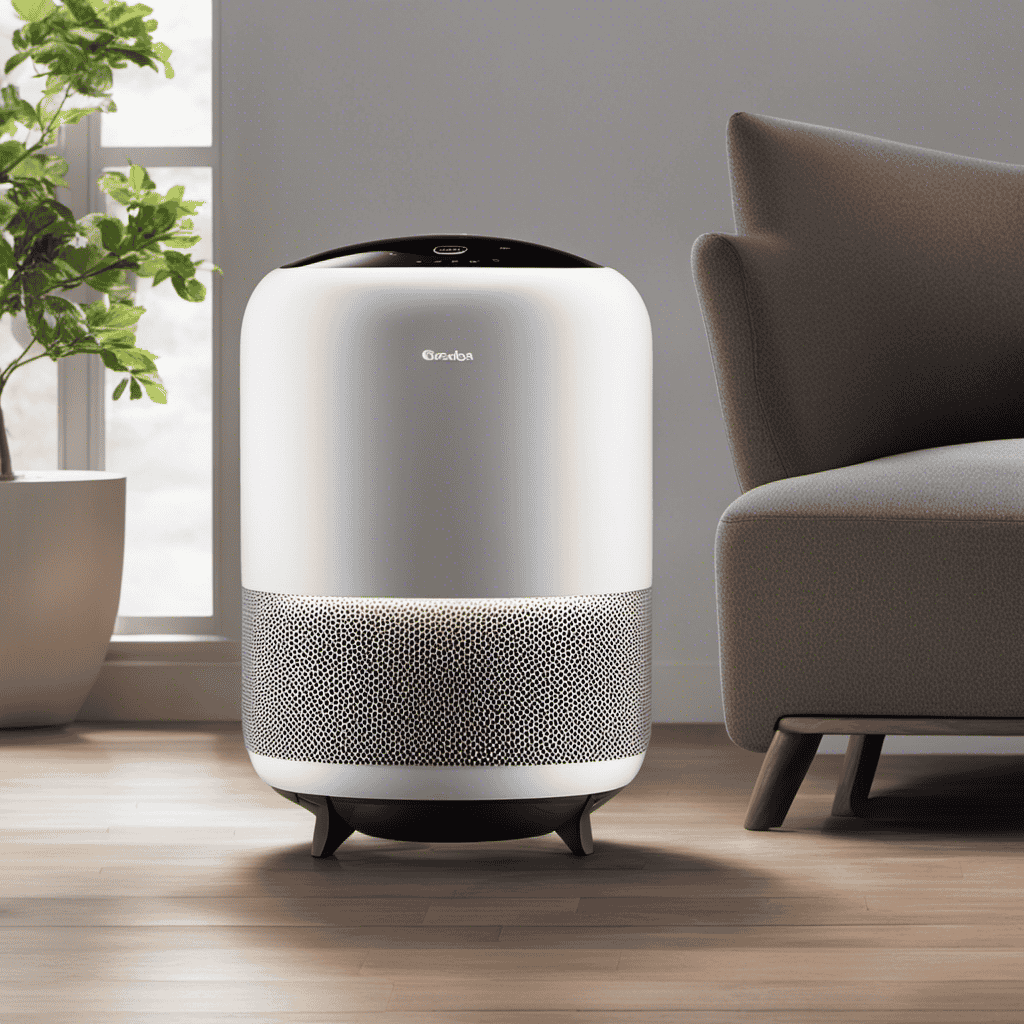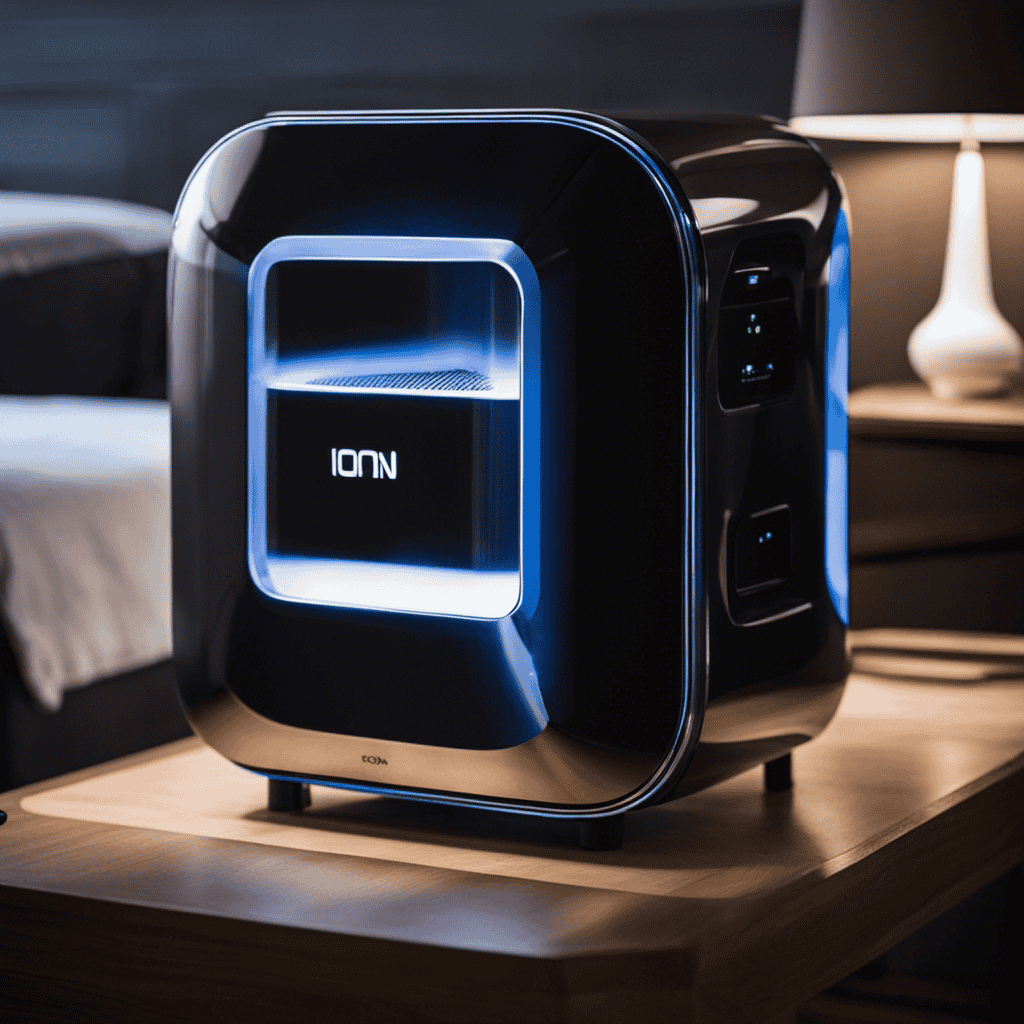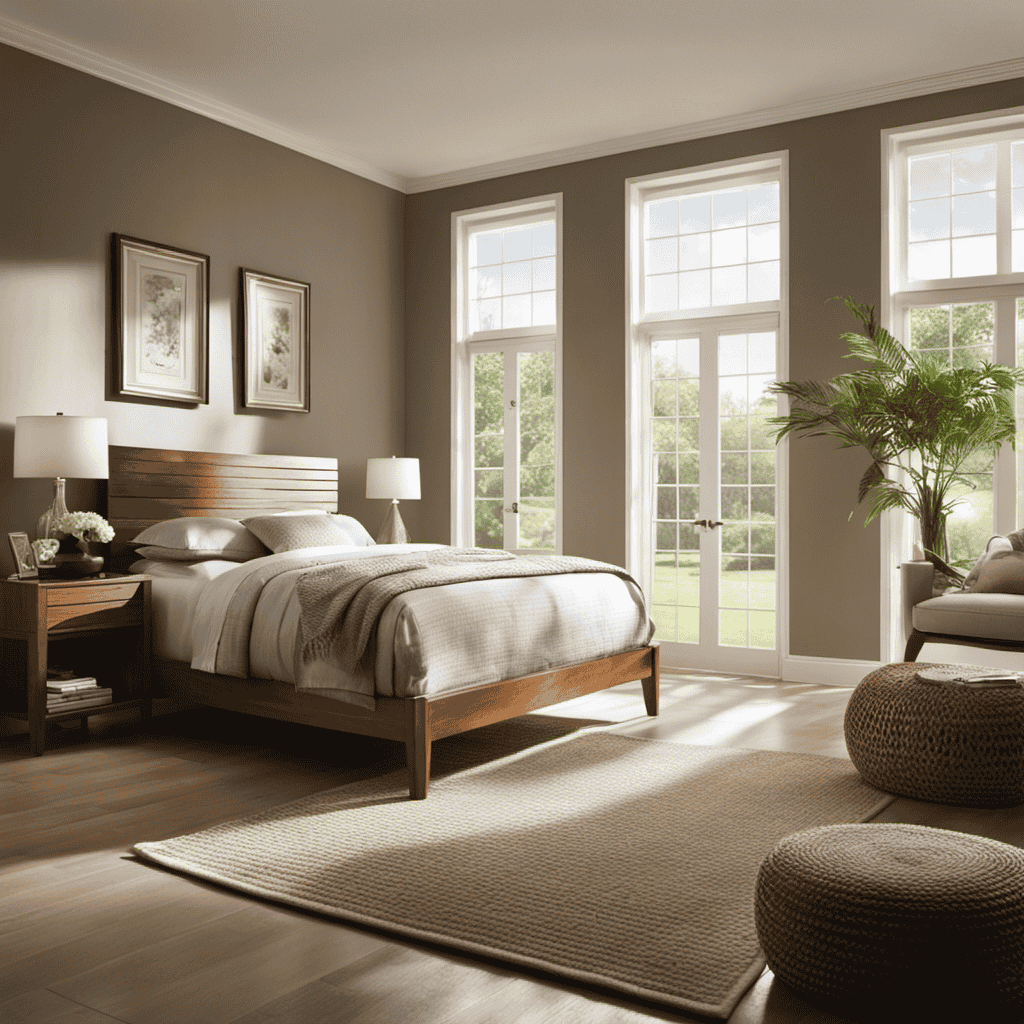I have always been interested in the technology behind air purifiers as someone who appreciates clean and fresh air. One feature that has captured my attention is the ionizer.
But what exactly does an ionizer do in an air purifier? In this article, we will delve into the science behind ionization and explore the benefits of using an ionizer in an air purifier.
So, if you’re like me and want to understand how ionizers work to improve air quality, keep reading!
Key Takeaways
- Ionizers emit negatively charged ions into the air to attach to airborne particles and make them heavier, causing them to fall or stick to surfaces.
- Ionizers also neutralize harmful pollutants like bacteria, viruses, and mold spores.
- Using an ionizer in an air purifier can help remove allergens and pollutants, improve air quality, alleviate respiratory symptoms, and promote better respiratory health.
- However, some ionizers may produce ozone as a byproduct, which can be harmful in high levels.
The Basics of Ionization
You might be wondering how an ionizer actually works in an air purifier. Well, let me explain the basics of ionization and ionizer technology.
An ionizer is a device that uses the ionization process to clean the air. It works by emitting negatively charged ions into the air. These ions attach themselves to airborne particles, such as dust, pollen, and smoke, making them heavier and causing them to fall to the ground or stick to surfaces. This effectively removes these particles from the air, improving indoor air quality.
The ionization process also helps to neutralize harmful pollutants, such as bacteria, viruses, and mold spores. So, when you turn on an air purifier with an ionizer, you can feel confident knowing that it is actively working to clean and purify the air in your home or office.
Understanding Ionizers in Air Purifiers
When using an ionizer, it’s important to understand how it functions in relation to improving indoor air quality. Ionizers are commonly found in air purifiers, where they help to remove pollutants and improve the overall air quality.
Unlike ozone generators, which produce ozone as a byproduct, ionizers work by releasing negative ions into the air. These ions attach themselves to airborne particles, such as dust, allergens, and bacteria, causing them to become heavy and fall to the ground. This process effectively removes these pollutants from the air, making it cleaner and healthier to breathe.
Ionizers are also commonly used in car air purifiers, where they help to reduce pollutants and improve the quality of the air inside the vehicle.
Understanding how ionizers work is crucial in order to fully appreciate their role in improving indoor air quality. Now, let’s delve into the details of how ionizers actually function.
How Ionizers Work
To fully understand how ionizers work, it’s important to grasp their role in improving indoor air quality.
Ionizers are a type of air purifier that use electromagnetic fields to produce charged particles, or ions, which are then released into the air.
These ions attach themselves to pollutants, such as dust, pollen, and pet dander, causing them to become heavy and fall to the ground. This process effectively removes these particles from the air, reducing the overall pollution levels.
However, it’s important to note that some ionizers can also produce ozone as a byproduct. Ozone, when present in high levels, can be harmful to human health.
Therefore, it’s crucial to choose an ionizer that has low ozone production or to use it in conjunction with other air purification methods to maintain a healthy indoor environment.
Benefits of Using an Ionizer in an Air Purifier
When it comes to improving air quality, using an ionizer in an air purifier can be highly beneficial.
An ionizer helps to remove allergens and pollutants from the air, making it cleaner and healthier to breathe.
Through the process of ionization, the ionizer charges particles in the air, causing them to stick to surfaces or be attracted to the air purifier’s filter, effectively removing them from the air.
Improved Air Quality
Using an ionizer in an air purifier can help improve air quality. An ionizer works by releasing negatively charged ions into the air, which attach to airborne particles, such as dust, pollen, and pet dander. These particles then become heavier and fall to the ground or are attracted to nearby surfaces. This process effectively reduces the number of pollutants in the air, leading to cleaner and healthier indoor environments. By reducing indoor pollutants, the ionizer can also have a positive impact on respiratory health. Breathing in cleaner air can help alleviate symptoms of allergies, asthma, and other respiratory conditions. Overall, incorporating an ionizer into an air purifier can significantly improve air quality and promote better respiratory health.
| Pros | Cons |
|---|---|
| Removes pollutants from the air | Ozone production |
| Reduces allergens and irritants | May generate ozone |
| Improves air quality | May have limited effectiveness on larger particles |
| Helps alleviate respiratory symptoms | Requires regular maintenance |
| Can enhance overall well-being | Some models may be noisy |
Allergen and Pollutant Removal
You can effectively remove allergens and pollutants from your indoor environment by incorporating an ionizer into your air purifier. An ionizer works by releasing negatively charged ions into the air. These ions attach themselves to airborne particles such as dust, pollen, and smoke, causing them to become heavier and fall to the ground. This process, known as ionization, helps to improve respiratory health by reducing indoor pollution.
By removing allergens and pollutants, ionizers can provide relief for individuals suffering from allergies or asthma. However, it is important to note that while ionizers are effective at removing certain particles, they may not be as efficient at capturing smaller particles or eliminating odors. This is where filtration comes in.
Transitioning to the next section, let’s explore the difference between ionization and filtration in air purifiers.
Ionization Vs. Filtration: What’s the Difference
When comparing ionization and filtration in air purifiers, it’s important to understand the benefits and effectiveness of each method.
Ionization, often used in combination with filtration, helps to remove particles from the air by charging them and causing them to stick to surfaces.
Filtration, on the other hand, physically traps particles in a filter, preventing them from circulating in the air.
Both methods have their advantages and drawbacks, and understanding their differences can help in making an informed decision when choosing an air purifier.
Ionization Vs. Filtration: Benefits
The benefits of ionization in an air purifier include reducing airborne particles and neutralizing odors. Here are three reasons why ionization can be advantageous compared to filtration:
-
Energy consumption: Ionization technology typically requires less energy compared to traditional filtration methods. This means that air purifiers with ionizers can operate more efficiently and save on electricity costs.
-
Noise levels: Ionizers tend to produce less noise compared to air purifiers with fan-based filtration systems. This is because ionizers do not require a fan to circulate air through a filter, resulting in a quieter operation.
-
Enhanced effectiveness: Ionization can complement filtration by targeting smaller particles that may escape traditional filters. By releasing ions into the air, ionizers attract and neutralize these tiny particles, providing an additional layer of purification.
Effectiveness of Ionizers
While ionizers are commonly used in air purifiers, they are also finding their way into other spaces, such as cars. Ionizers in cars work by releasing negatively charged ions into the cabin, which attach to positively charged particles like dust, pollen, and smoke. This causes the particles to become too heavy to remain airborne, leading them to settle on surfaces or be trapped by the car’s ventilation system.
One concern with ionizers in cars is their energy consumption. However, ionizers typically consume very little energy, especially compared to other electronics in the car. Most ionizers in cars use less than 1 watt of power, which is negligible compared to the energy consumed by the car’s engine or other electrical components. Therefore, the energy consumption of ionizers in cars is minimal and unlikely to have a significant impact on the overall energy efficiency of the vehicle.
Common Misconceptions About Ionizers
One common misconception about ionizers is that they produce harmful ozone. However, this is not entirely true. While it is true that some ionizers can produce small amounts of ozone, the levels are typically well below the safety limits set by regulatory agencies. In fact, many ionizers on the market today are specifically designed to emit minimal ozone or are ozone-free altogether.
To help debunk some of the myths surrounding ionizer safety, here are three important facts to consider:
-
Most ionizers have built-in safety features that limit ozone production. These features ensure that the ozone levels emitted by the ionizer remain within safe limits.
-
Ozone is naturally present in the environment and can be found in higher concentrations outdoors, especially in urban areas. The small amount of ozone emitted by ionizers is unlikely to cause any harm.
-
Numerous studies have been conducted to evaluate the safety of ionizers, and the overall consensus is that when used properly, ionizers pose no significant health risks.
The Science Behind Ionization
Understanding the science behind ionization can help us make informed decisions about using ionizers for improving indoor air quality. Ionizers work by releasing negative ions into the air, which attach to positive particles like dust, pollen, and pet dander. This process, known as ionization, causes these particles to become heavy and fall to the ground or stick to surfaces, effectively removing them from the air we breathe.
But what impact do ionizers have on indoor air quality? Let’s take a look at the table below to understand the benefits and considerations of using ionizers:
| Benefits | Considerations |
|---|---|
| Removes airborne particles | Ozone production |
| Reduces allergens | Maintenance requirements |
| Neutralizes odors | Potential health effects |
| Improves air circulation | Limited effectiveness against certain pollutants |
| Enhances overall indoor air quality |
Choosing the Right Ionizer for Your Air Purifier
To choose the right ionizer for your needs, it’s important to consider factors like room size, noise level, and maintenance requirements. With advancements in ionizer technology, there are now more options available to improve the air quality in your home.
Here are three key factors to consider when choosing the right ionizer:
-
Room Size: Determine the square footage of the room you want to purify. Different ionizers have varying coverage areas, so make sure to choose one that can effectively clean the air in your specific room size.
-
Noise Level: Consider the noise level produced by the ionizer. Some ionizers operate quietly, while others can be a bit noisier. If you plan to use it in a bedroom or office, you may want to opt for a quieter model.
-
Maintenance Requirements: Look into the maintenance requirements of the ionizer. Some models may require frequent filter replacements or cleaning, while others have washable filters or longer-lasting components.
Maintaining and Cleaning an Ionizer
When it comes to maintaining and cleaning your ionizer, you’ll want to follow the manufacturer’s instructions to ensure optimal performance. Cleaning techniques may vary depending on the specific model of your air purifier, so it is important to consult the user manual for guidance.
In general, it is recommended to clean the ionizer regularly to remove any accumulated dust or debris. This can be done by gently wiping the ionizer with a soft, damp cloth or using a brush to remove any particles. It is important to avoid using harsh chemicals or abrasive materials that could damage the ionizer.
Additionally, regular maintenance, such as replacing filters and checking for any signs of wear or damage, is crucial to keep your ionizer functioning effectively. Following these recommended maintenance practices will help ensure that your ionizer continues to purify the air in your home efficiently.
Potential Health Risks of Ionizers
In terms of health effects and safety concerns, ionizers in air purifiers have been the subject of some debate. While they are designed to remove particles from the air, there are a few potential risks to consider:
-
Ozone production: Some ionizers generate ozone as a byproduct, which can irritate the respiratory system and worsen existing conditions like asthma. It’s important to choose an ionizer with low ozone emission or opt for ozone-free alternatives.
-
Lung irritation: The charged particles produced by ionizers may irritate the lungs, leading to coughing, wheezing, and shortness of breath. This can be especially problematic for individuals with respiratory conditions.
-
Chemical reactions: Ionizers can interact with other chemicals in the air, such as volatile organic compounds (VOCs), to produce harmful byproducts. This can potentially lead to indoor air pollution, rather than improving air quality.
Considering these potential risks, it’s crucial to carefully evaluate the health effects and safety concerns associated with ionizers before incorporating them into your air purifier.
Now let’s explore whether ionizers can actually help with allergies.
Ionizers and Allergies: Can They Help
Using an ionizer in your home may provide relief for allergies by reducing airborne allergens. Ionizers, also known as air purifiers, work by releasing negatively charged ions into the air that attach to positively charged particles, such as dust, pollen, and pet dander. This process causes these particles to become heavy and fall to the ground or stick to surfaces, effectively removing them from the air.
In turn, this can help reduce the amount of allergens that you breathe in, potentially alleviating symptoms associated with allergies, such as sneezing, coughing, and itchy eyes. While ionizers can be beneficial for allergy sufferers, it is important to note that they may not be as effective in managing asthma symptoms. Asthma is a more complex condition that involves inflammation and constriction of the airways, and while reducing airborne allergens can be helpful, it is not the only factor to consider in asthma management.
Therefore, it is best to consult with a healthcare professional for personalized advice on managing asthma and respiratory health.
The Role of Ionizers in Removing Odors
To effectively eliminate odors in your home, ionizers play a crucial role. They release negatively charged ions that attach to particles in the air, making them heavier and causing them to fall or stick to surfaces.
Here’s how ionizers work to remove odors and improve indoor air quality:
-
Neutralizes Odor Molecules: Ionizers release negative ions that react with odor molecules, breaking them down into smaller, less pungent compounds.
-
Removes Smoke and Cooking Odors: Ionizers are particularly effective in removing smoke and cooking odors. They neutralize the volatile organic compounds (VOCs) responsible for these odors.
-
Eliminates Pet Odors: Ionizers can help reduce pet odors by neutralizing the odor-causing molecules present in pet dander and urine.
Ionizers and Bacteria/Virus Elimination
Ionizers are effective at reducing the presence of bacteria and viruses in the air, creating a healthier environment. These devices work by releasing negatively charged ions into the air, which attach to airborne particles and cause them to become heavier. As a result, these particles are less likely to remain suspended in the air and can be easily captured by air purifiers or settle onto surfaces. This process helps to reduce the overall concentration of bacteria and viruses in the air, minimizing the risk of respiratory infections and illnesses. Studies have shown that ionizers can significantly reduce the levels of airborne bacteria and viruses, leading to improved respiratory health. Additionally, ionizers can also help to alleviate symptoms of allergies and asthma by removing allergens and irritants from the air.
| Benefit | Ionizers and Air Pollution Reduction | Ionizers and Respiratory Health Benefits |
|---|---|---|
| Reduces | Yes | Yes |
| bacteria | ||
| Reduces | Yes | Yes |
| viruses | ||
| Alleviates | No | Yes |
| allergies | ||
| Alleviates | No | Yes |
| asthma |
Ionizers in Commercial Air Purifiers
The effectiveness of ionizers in commercial air purifiers can be seen in their ability to reduce the presence of bacteria and viruses, creating a healthier environment. As someone who is concerned about air quality, I appreciate the benefits that ionizers provide. Here are three reasons why ionizers in commercial air purifiers are worth considering:
-
Improved indoor air quality: Ionizers release negatively charged ions into the air, which attach to airborne particles such as bacteria and viruses. This causes them to become heavy and fall to the ground, reducing their presence in the air we breathe.
-
Odor elimination: Ionizers also help to eliminate unpleasant odors by neutralizing odor-causing particles. This can be particularly beneficial in commercial spaces such as offices, where multiple individuals may contribute to the buildup of odors.
-
Allergy relief: By capturing and removing allergens like pollen, pet dander, and dust mites, ionizers can provide relief for individuals with allergies or respiratory conditions. This can lead to improved productivity and overall well-being in commercial settings.
While the effectiveness of ionizers in residential air purifiers and automotive air purifiers may vary, their benefits in commercial settings make them a valuable addition to any air purification system.
Ionizers in HVAC Systems: Pros and Cons
Using ionizers in HVAC systems can have both advantages and disadvantages.
One of the main advantages is improved energy efficiency. Ionizers work by releasing negatively charged ions into the air, which attach to pollutants and particles, making them heavier and causing them to settle. This reduces the amount of airborne contaminants that need to be filtered, resulting in less strain on the HVAC system and potentially lower energy consumption.
Additionally, ionizers can help to improve indoor air quality by reducing allergens and odors.
However, there are also some drawbacks to consider. Ionizers require regular maintenance to ensure their effectiveness, as the plates or collectors can become dirty and need to be cleaned or replaced. Furthermore, some studies have raised concerns about the potential production of ozone by ionizers, which can be harmful to human health in high concentrations.
Therefore, it is important to weigh the pros and cons before deciding to use ionizers in HVAC systems.
What is the Function of an Ionizer in an Air Purifier?
An ionizer in an air purifier works by releasing negatively charged ions into the air. These ions attach themselves to airborne particles, making them too heavy to remain airborne. As a result, the particles fall to the ground or get collected by the purifier, effectively removing them from the air.
Frequently Asked Questions
Can Ionizers Remove Pet Dander and Pet Hair From the Air?
Yes, ionizers can help remove pet dander and pet hair from the air. They release negatively charged ions that attach to the positively charged particles, causing them to clump together and fall to the ground or get trapped in the air purifier’s filter.
Are Ionizers Safe to Use Around Children and Pets?
I’m not sure about the potential health risks of ionizers, but I do know that they work differently than HEPA filters. It’s important to consider the safety of using ionizers around children and pets.
Do Ionizers Produce Any Harmful Byproducts or Ozone?
Ionizers in air purifiers can have harmful effects on health. They produce byproducts and ozone, which can lead to respiratory issues. It’s important to be aware of these potential health concerns when using an ionizer.
Can Ionizers Eliminate Cigarette Smoke and Its Odor?
Yes, ionizers can eliminate cigarette smoke and its odor by releasing negatively charged ions that attach to the smoke particles and neutralize them. They can also help in reducing cooking odors and allergens.
How Often Do Ionizers Need to Be Replaced or Cleaned?
Cleaning the ionizer in an air purifier is crucial for its proper functioning and efficiency. Regular maintenance, like cleaning every 3-6 months, ensures optimal performance and helps remove airborne particles effectively.
Conclusion
In conclusion, ionizers play a crucial role in air purifiers. They release negatively charged ions into the air. These ions attach themselves to airborne particles, causing them to become heavy and fall to the ground or stick to surfaces. This effectively removes them from the air we breathe.
Ionizers have been praised for their ability to eliminate odors and potentially reduce the presence of bacteria and viruses. However, it is important to note that more research is needed to fully understand their effectiveness in these areas.
Nonetheless, when used in conjunction with filtration systems, ionizers can provide an extra layer of purification to improve indoor air quality.









